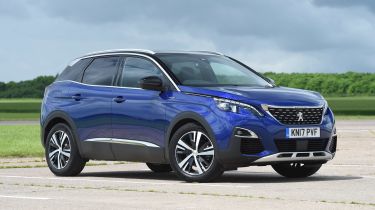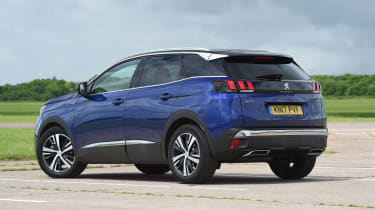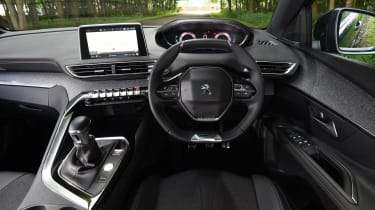Used Peugeot 3008 (Mk2, 2017-date) review
A full used buyer’s guide to the Peugeot 3008 covering the 3008 Mk2 (2017-date)
Verdict
We were so impressed with the 3008 when it arrived that we named it Best Mid-Size SUV in our 2017 New Car Awards. Our sister title Carbuyer then crowned it Car of the Year. We ran an early 1.6 BlueHDi for a year and absolutely loved it, commenting that “it’s practical, efficient and good to drive, while also being full of technology and French style”. Most owners seem to agree, with many also liking the low running costs and decent reliability – proving that Peugeot really did turn a corner with this car.
Peugeot was founded in 1810, and started building cars 131 years ago – and the manufacturer has never been afraid to innovate. Over the years it has produced some great models, but things went off the boil noticeably at the start of the 21st Century, thanks to disappointing reliability and so-so design.
The company began fighting back a decade or so ago, however, with appealing cars such as the 208 and 308. The original 3008 that arrived in 2010 was part-SUV, part-MPV, and it was worthy if unexciting. But the second take was an out-and-out SUV, and it was all the better for it thanks to its rugged styling, upmarket interior, much-improved engines and gearboxes, plus a strong driving experience.
Used - available now
Models covered
- Peugeot 3008 Mk2 (2017-date) – The award-winning Mk2 3008 will transport you in comfort and style, and is good to drive.
History
The first 3008 Mk2s were delivered in April 2017, with buyers able to choose between 128bhp 1.2-litre PureTech or 163bhp 1.6 THP petrol engines, or 1.6 or 2.0 BlueHDi diesels. All were available with an optional six-speed auto transmission, but there was no four-wheel drive; all models set drive to the front wheels.
However, there was a 4x4 version from January 2020 thanks to the launch of the Hybrid4 – a 296bhp petrol-electric plug-in hybrid. Within weeks there was also a cheaper, 222bhp front-wheel-drive PHEV. A facelifted 3008 arrived in January 2021 with a refreshed nose, extra standard kit, optional Night Vision technology and a new trim structure (Active Premium, Allure, Allure Premium, GT, GT Premium).
Which one should I buy?
All engines are good enough, but if you are going to be filling up your 3008 with people or undertaking long journeys, the diesel’s extra muscle and economy will be welcome. Previous Peugeot EAT (Efficient Automatic Transmission) gearboxes were disappointing, yet the Mk2 3008’s auto boxes are superb.
All 3008s are well equipped, with even the entry-level Active model getting auto headlights and wipers, 17-inch alloys, DAB radio, Apple CarPlay and Android Auto, dual-zone climate control and rear parking sensors. Allure trim adds privacy glass, front parking sensors, navigation and 18-inch wheels, while GT Line brings posher interior trim and LED headlights. The GT Line Premium adds heated front seats, a panoramic roof and 19-inch alloys.
Alternatives to the Peugeot 3008 Mk2
The popularity of mid-size SUVs means that the 3008 is up against some tough competition, not least of all the multi-talented Nissan Qashqai. This is readily available and very family friendly, but not always as reliable as you’d expect. Three Volkswagen Group rivals are the SEAT Ateca, Skoda Karoq and VW Tiguan, all of which are desirable for their build quality, efficient engines and user-friendly cabins.
The Mazda CX-5 is great to drive and has a superb cabin, while the Ford Kuga is keenly priced, with plenty to choose from and generous kit. Don’t overlook the Kia Sportage or its cousin the Hyundai Tucson, which are reliable and great value, while the Renault Kadjar should also be on your shortlist, alongside the MINI Countryman.
What to look for
Codenames
The original 3008 was codenamed T8 by Peugeot, whereas its successor (covered here) is known internally as the P84.
Engines
In spring 2018 a new 1.5-litre diesel powerplant was introduced, but the older 1.6 diesel unit was still sold alongside it for a while.
Leaks
The panoramic roof has been known to suffer from significant water leaks – and unfortunately fixes for this reportedly remain rather elusive.
Radio
DAB radio reception can be poor, and this problem is said to get worse if a USB adaptor is plugged into the car’s 12-volt socket and being used.
Interior
The 3008’s cabin blends great design with a premium feel. Add in comfortable seats and a standard digital dash, and Peugeot really has got things sewn up. Some owners don’t like the small steering wheel, but this works better in the 3008 than in some of Peugeot’s other models. Rear space is okay, but the pay-off is a large, 520-litre boot, which expands to 1,482 litres (395/1,357 for hybrids).
Running costs
The 3008 needs servicing every year or 16,000 miles. The first is £199, the second £269, then they alternate between £199 and £329. Dealers offer a £99 oil change at four years. Brake fluid is needed every two years at £59, coolant after four years or 80,000 miles, then every year or 16,000 miles; the £329 service covers this.
The 1.6 petrol engine is chain driven; the diesels and 1.2 petrol’s cambelt needs replacing every 10 years or 112,000 miles at £499 (OE parts) or £399 (pattern parts).
Prices
You can view prices for a Mk2 Peugeot 3008 from our Find a Car service or view prices for a specific model from our free car valuation tool.
Recalls
The 3008 Mk2 has been recalled 12 times, the first three in 2017 for faulty starters, then one for fuel leaks and one for stalling. In 2018, there was one for overheating and another for oil leaks. Faulty rear-suspension bolts and diesel emissions brought recalls in 2020. Faulty timing belts and sub-standard tow bars led to actions in 2021.
Driver Power owner satisfaction
If you were in any doubt about the 3008’s desirability, you can be reassured by its Driver Power performance. It came first upon its debut in our 2018 survey, followed by a seventh place in 2019 before going back up to second last year. Owners love the refinement, cabin design and quality, maintenance costs and great drive – but not so much the infotainment or ventilation.
















